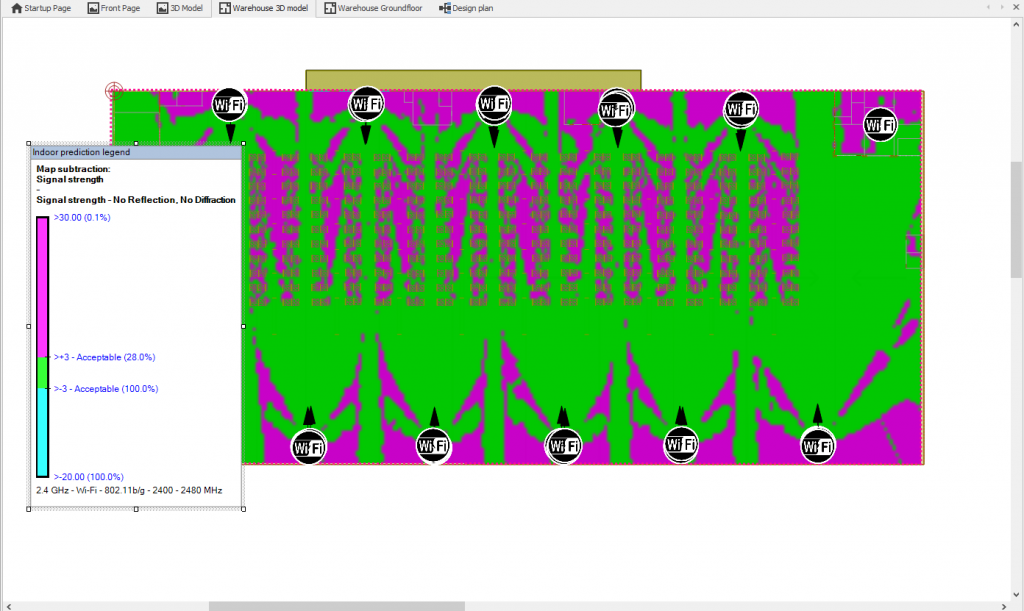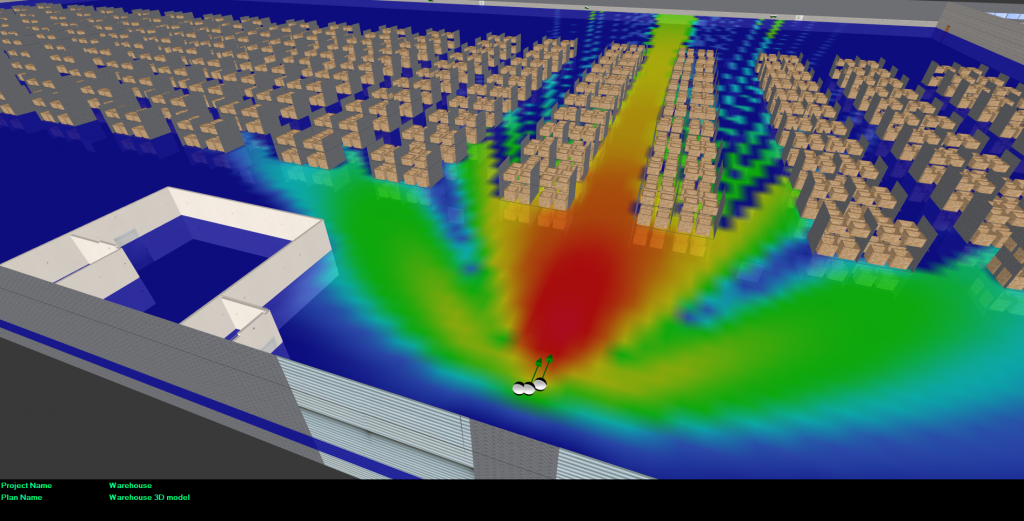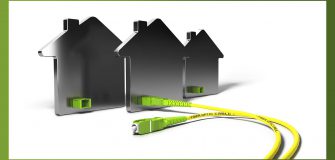What’s the Impact of Reflection and Diffraction on Prediction Accuracy?
Share

Depending on the venue you’re designing, considering reflection and diffraction can make anywhere from a small to a very large difference. Take a small open office space for example – reflection and diffraction probably don’t make such a large difference. But when you look at more complex venues such as a warehouse, or large manufacturing facility full of metal shelves, machinery and inventory? You’re going to see a much larger difference.
To dive deeper into what this looks like and the impact it can have, I took an example warehouse modeled with inventory shelves and boxes and predicted network performance in two ways:
- Considering both reflection and diffraction in the prediction results (the default in iBwave)
- Without reflection and diffraction in the prediction results
By running these two scenarios, I could see the impact considering reflection/diffraction in prediction vs. just looking at direct path can have on a design. I did this both for the overall design and then later one just looking at one access point in isolation.
About the Venue and Design
The venue I used is a demo warehouse that has been modeled with offices, metal shelves with stacked inventory boxes, and the then the usual walls and metal roof structure of a typical large warehouse venue. In terms of the Wi-Fi network design, there are a total of 14 APs placed with antennas. Details can be seen on the Bill of Materials report.

In 3D the warehouse model looks like this ?

Prediction Results: With Reflection & Diffraction Considered
The first scenario I wanted to look at was the default scenario in iBwave where both reflection and diffraction of the wireless signals are considered as they move through the warehouse space and objects – this is done using the Fast Ray Tracing prediction method, the most accurate of the three available (others include VPLE, and COST231) . It’s essentially what would be considered the most accurate prediction simulation.
Looking at the Signal Strength heatmap for 2.4GHz you see the coverage of the warehouse floor.

And in 3D…

Prediction Results: No Reflection & Diffraction Considered
Next, I went into the output map configuration options and removed the option to consider reflection and diffraction from the prediction algorithm to see what the impact would be on the simulation of the network performance. (Note: this feature is only available for internal debugging purposes and is not in the general release of the software.)
Then I ran the 2.4GHz Signal Strength heatmap again to see what the difference in results were compared to when the algorithm considered reflection/diffraction. You can see just from the heatmap visual alone there is a difference, where because reflection and diffraction are not considered, the prediction considers only direct path and as a result shows more areas of weak signal (blue).


Taking a Closer Look at the Difference
Now that we’ve simulated both scenarios – with reflection/diffraction versus without – we can examine the difference between the two closer using two different ways:
- By using the heatmap probe to closer examine the result of the heatmaps in specific spots
- Generate a ‘Subtraction Heatmap’ which will show the performance difference between the two heatmaps – basically results with reflection vs. results without.
Using the Subtraction Heatmap
First let’s look at the Subtraction Heatmap which gives us an overall view of what the difference is between the heatmaps that consider reflection/diffraction, and the heatmap that does not.
Considering a difference of +/- 3dBM as acceptable, you can see that while the majority of the heatmap falls into this category (green), there are some rather large areas (purple) that fall into an unacceptable range ( > 3 dBM and up to 30 dBM).

Using the Heatmap Probe
Now using the probe tool on the heatmap, we can mouse over specific spots and get a comparison reading for the ‘With Reflection/Diffraction’ heatmap versus the ‘Without Reflection/Diffraction’ heatmap. By doing this, we can see a difference of up to 30 dBm in some areas, and in this particular spot it is a significant difference of -24.70 dBm.

Looking at an Example in Isolation
Next, I wanted to just isolate one access point and run prediction with/without reflection and diffraction considered to see the impact from an isolated perspective.
Here are the results when reflection and diffraction are considered in the prediction algorithm. Using the 3D view of the heatmap, you can see how the signal coming out from the AP reflects and diffracts as they meet the shelves and inventory of the warehouse.

When you remove the reflection and diffraction from the prediction algorithm, you see how only the direct path is considered, giving a very straight pathway down the inventory shelves in the warehouse. Again, the 3D view helps us visualize that impact pretty easily, especially towards the end of the inventory row where you see no reflection/diffraction off the objects in the path.

What’s the Impact?
Given the large difference in prediction results when looking at this example of a warehouse, it becomes obvious that considering reflection and diffraction within the prediction results can have a significant impact on the accuracy of the network performance simulation. In this case, without considering it, the network designer may add more APs where weak signal zones appear because only direct path is considered in the simulation. As a result, the network may be over-designed leading to more cost and issues that require troubleshooting once the network is installed and turned on.
In a more open floor plan, reflection and diffraction probably would not have such a large impact. But in environments where there is a lot of metal and obstacles (warehouse being a great example) , considering the impact of reflection and diffraction in the prediction algorithm has a significant impact on the accuracy of your network simulation, and design.
Wirelessly yours,
Kelly
- Cleared for Takeoff: Private Networks in Aviation - January 21, 2025
- A Tour of iBwave Viewer - November 23, 2020
- Introducing Augmented Reality in iBwave Wi-Fi Mobile - September 10, 2020





















It is very clear the difference and more realistic. The impact is considered in the BoM/BoQ as well as the performance, where refraction/difraction is not used we could se less interference so we would think that the performance is better, but when use refraction/diffraction the rays contributes to the SNR, so we see the real scenario leaving room for optimization purposes.